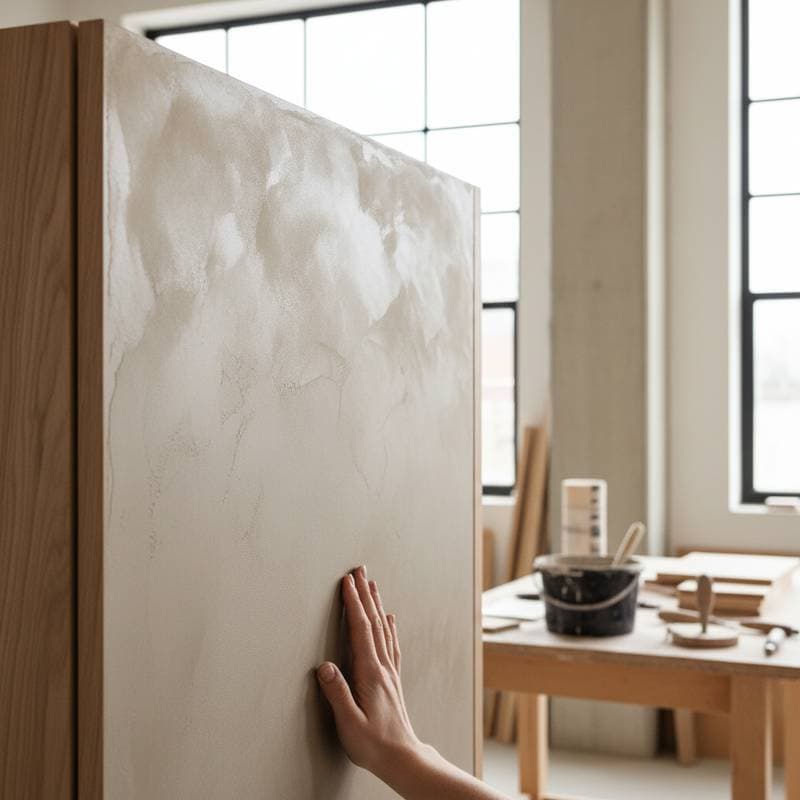Venetian Plaster: Wood's 2025 Luxe Finish Revolution
Venetian plaster transitions from walls to wood surfaces. Once limited to grand villas, this finish now enhances high-end cabinetry, furniture, and custom millwork with its soft sheen and layered depth. The approach combines old-world craftsmanship and modern precision to produce luminous, tactile wood that appears both refined and artisanal.
At a Glance
Project Type: Custom residential interiors and boutique furniture pieces
Material Focus: Venetian plaster on hardwood and engineered substrates
Design Teams: Studio Maren Design, Formline Workshop, and Atelier Verde
Photographers: Lila Grant and Thomas Roe
Designers view this evolution as a return to texture. Lacquer dominated earlier, but plaster introduces warmth and dimension. Interior designer Clara Maren notes, “We wanted a finish that feels alive. Plaster moves with the light, and on wood it softens everything.”
Before
Luxury wood finishes relied on high-gloss lacquer or oil-based varnish for decades. These coatings sealed the grain and reflected light sharply, yet they often resulted in uniform, sterile appearances. Builders appreciated the durability but struggled with repairs, while homeowners noticed fingerprints and scratches more readily than natural aging.
Cabinetmaker Jonas Reed remembers the difficulties. “Clients wanted depth without shine,” he explains. “We tried stains and waxes, but they lacked that mineral glow you get with plaster.” The market sought a blend of traditional artistry and contemporary subtlety.
After
Venetian plaster on wood achieves this equilibrium. Artisans apply thin layers with a steel trowel to build translucency and reveal subtle surface movement. A final polish with a burnishing stone or fine pad yields a soft sheen, distinct from gloss.
Professionals apply it to walnut sideboards, oak wall panels, and maple kitchen islands. Pigments and techniques vary the effect: a pale limestone tint evokes coastal airiness, while charcoal on rift-cut oak provides an architectural foundation. The process begins with a sealed base coat to control moisture, followed by two or three fine plaster layers, each burnished before the next. A wax or microseal finish protects against water, fingerprints, and wear while preserving the handmade quality.
Lighting enhances the impact. Directional sconces or linear LEDs graze the surface to highlight movement that lacquer would suppress. Builder Sam Lee of Formline Workshop observes, “It changes through the day. Morning light shows the brush strokes. At night it glows like stone.”
Design Details
- Base Preparation: Apply a shellac or acrylic sealer to block wood tannins from bleeding into the plaster.
- Layer Thickness: Each coat measures about 1/32 inch (0.8 mm). Three layers typically ensure complete coverage.
- Burnishing: Polish by hand with a stainless trowel or stone to achieve a satin reflection.
- Protection: Seal with microcrystalline wax or matte urethane for added durability.
- Color Range: Options include natural lime whites, ochres, deep charcoals, and subtle metallic tints.
- Lighting Strategy: Employ wall-grazing or recessed trimless lights to accentuate depth and texture.
These elements ensure the finish remains durable and expressive. The tactile quality encourages interaction with wood furnishings.
Why It Matters
The adoption of Venetian plaster signals a broader redefinition of luxury. Gloss yields to subtle glow, as homeowners seek breathable surfaces that reveal the artisan's touch yet withstand daily demands. This aligns with preferences for natural materials, using lime, marble dust, and pigment over wood for a timeless hybrid.
Designer Maren adds, “It is not just about looks. Plaster regulates humidity and hides small wear over time. It feels more forgiving than lacquer.” Low-VOC, breathable formulations reduce moisture buildup, preventing wood shifts or cracks and enhancing sustainability.
Applying the Look at Home
Test Venetian plaster on small wood items before larger installations. Prepare a sample board or drawer front by sanding and sealing, then add a thin layer with a flexible trowel. Allow drying, burnish, and apply additional coats as needed.
For understated results, skip polishing the top layer. For bolder impact, burnish and wax to reveal marble-like depth. Evaluate colors under intended lighting, as tones shift with conditions.
In kitchens or baths, integrate plastered panels with matte stone counters and brushed metal hardware for refined appeal. In living spaces, use plastered wood panels in place of painted wainscoting to provide subtle movement that supports art and furniture.
Smart Storage Moves
- Install plastered drawer fronts on hidden storage walls for a seamless, sculptural appearance.
- Add plastered back panels to open shelves to diffuse light gently.
- Pair plaster fronts with solid wood frames to manage costs and weight effectively.
These tactics allow assessment of upkeep and variations prior to full-room commitments.
Trade Offs to Consider
Venetian plaster demands time and a stable environment, not a simple weekend task. Layers require full curing between applications, with temperature and humidity influencing dry times. Schedule accordingly to avoid issues.
Costs range from 8 to 12 dollars per square foot (86 to 129 dollars per square meter) for materials, based on pigments and methods. Labor increases expenses due to the hands-on nature of application and burnishing.
Maintenance proves straightforward, however. Buff or rewax minor scratches without full refinishing, unlike lacquer.
Key Takeaways
- Venetian plaster elevates wood to luminous, tactile realms, merging craftsmanship with resilience.
- Layering and burnishing produce adaptive soft reflections under varying light.
- Natural, breathable components promote healthier, enduring wood applications.
- Strategic lighting and color choices amplify the surface's vitality in everyday settings.
- Though demanding in execution, the outcome delivers enduring sophistication beyond fleeting styles.
This finish enhances modern minimalism and classic millwork alike. It harmonizes with neutral schemes and materials like linen, stone, and brushed metals.
Living with Your Design
Venetian plaster surfaces mature elegantly over time. Dust regularly with a soft cloth for cleanliness. Rewax periodically every few years to renew the sheen, and steer clear of harsh cleaners, as lime-based formulas react to acids.
A subtle patina emerges gradually, enhancing character. Homeowner Elise Tran shares, “It is like leather,” regarding her plastered oak cabinets that define her kitchen.
This innovative application of Venetian plaster reshapes wood finishing. It honors texture, light, and tactile experience.
